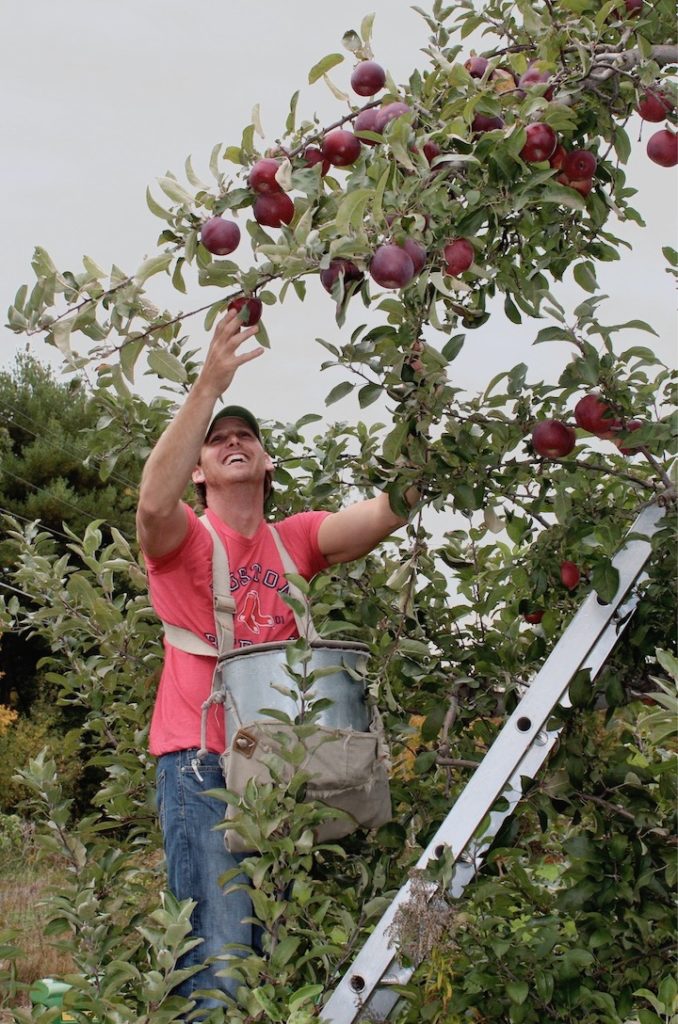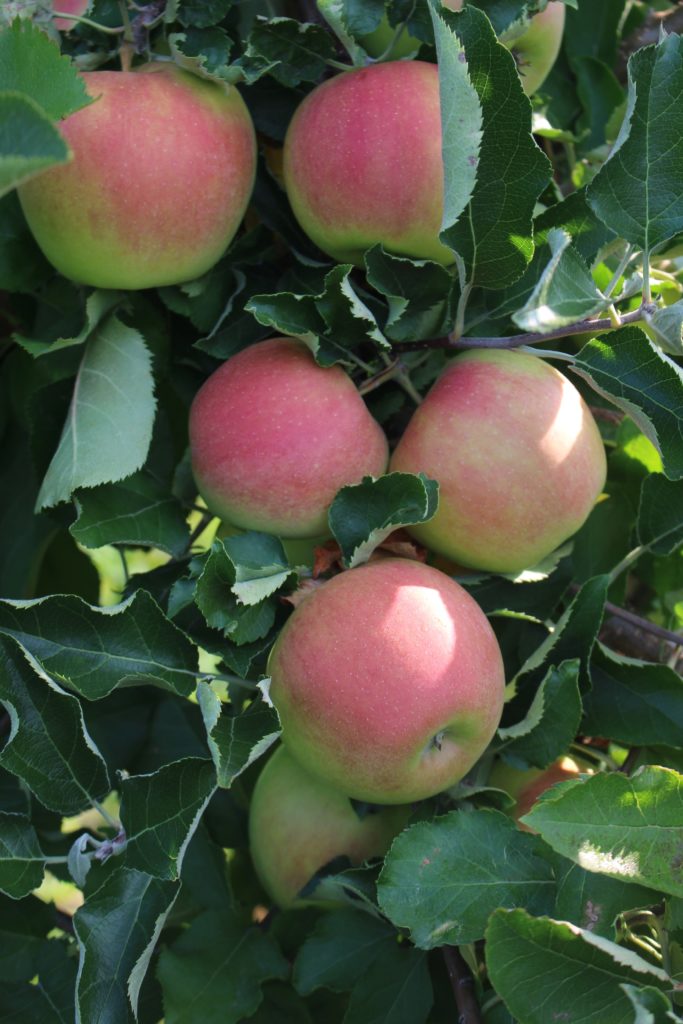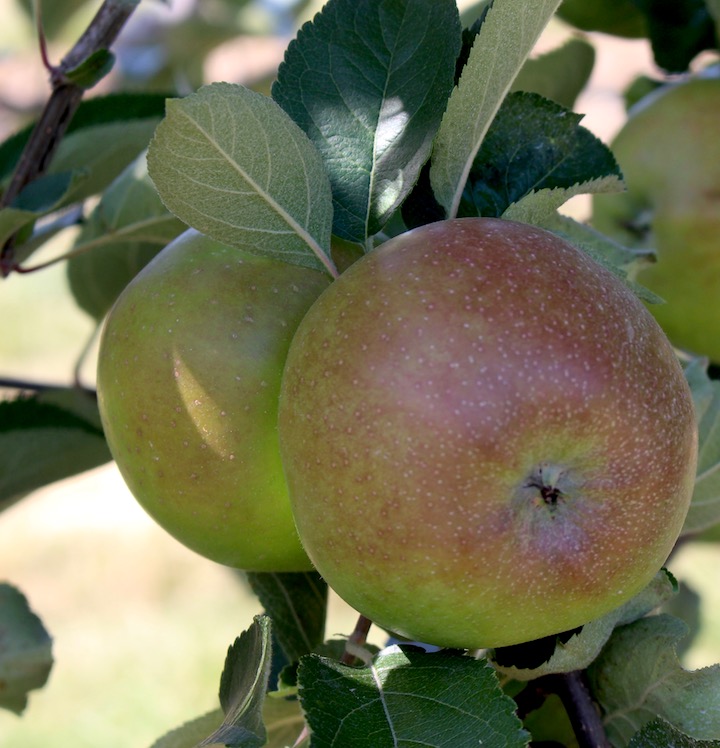
EMPIRE AND JONAGOLD, two of the best later-season apples, are now ready at New England orchards, farm stands, and grocery stores.
Both varieties are beautiful to behold, crisp and juicy, more sweet than tart with a pleasing spiciness, and good for both cooking and fresh eating. FYI: We like Jonagold better than Honeycrisp!
But while eagerly awaited by many, the popularity of Empire and Jonagold has never reached the heights of their superior quality. It’s hard to pinpoint why. One reason may be their bland names; they can get overlooked in a sea of descriptively-named apples like Honeycrisp, RubyMac, and CrimsonCrisp, and stalwarts like McIntosh and Macoun.
Both Empire and Jonagold were introduced in the 1960s, when marketing of fresh fruit was in its infancy. Compared to today’s competitive produce aisles, these names lack a certain panache. Empire was given New York’s nickname because it was developed there. Jonagold was straightforward taxonomy, combining the names of its two parents, Jonathan and Golden Delicious.
These two great apples should not be overlooked due to their pedestrian names. Once you’ve tried them, you won’t forget them.
* * *

CORTLAND, MACOUN, AND McINTOSH, three of New England’s most popular apples, also have names that do not intrinsically say “apple.” But they have been around for more than a century and have become synonymous with the fruit.
Cortland is a city and county in New York state. Macoun (pronounced “Ma-cown, rather than Ma-coon”) and McIntosh are family names.
But even McIntosh’s name has been appropriated by the high-tech company Apple, although they misspell it for their line of Macintosh computers.
Add a “k,” and you have the similar-sounding mackintosh waterproof coat.
Still, when you say “McIntosh,” most New Englanders immediately think of the iconic apple. Same with Cortland. And there’s no other meaning for Macoun than the apple which bears its name.
Surprisingly, though, in today’s sophisticated marketing era, many newly named varieties face the same handicap as Empire and Jonagold — and these newcomers have yet to demonstrate they are of equal quality.
Like Empire and Jonagold, Jazz, Envy, and SnapDragon say nothing about the trademarked apples for which they are named. Does anyone really believe that the word “jazz” will ever evoke the apple rather than the music genre? Or that “envy” will summon up anything other than the emotion? Will “snapdragon” ever come to signify the fruit rather than the flower?
These gimmicky names may give these apples a short-term boost for their novelty, but it may not last unless the apples prove as good as Empire and Jonagold, still flourishing into their sixth decade.
* * *

THE OLDER THE APPLE, the more likely it will have multiple names.
Many apples were named for the place where they were first grown (Roxbury Russet, 1635, aka Boston Russet, Leather Coat, and a dozen others), or the person that discovered it (Baldwin, aka Butters and Ball).
When the farm was sold or the same apple was grown in a new place, it was often given a new name. Perhaps it included some characteristic of the apple, like its shape (Sheep’s Nose, aka Black Gilliflower), color (Black Oxford), season or taste (Early Strawberry, aka Red Juneating, American Red Juneating).
As an apple accrues different names, though, it can complicate the matter of identity. The Apple Farm in Skowhegan, Maine, has a small but beautiful crop of an apple they call “Roy Slamm” after the man, now deceased, who first drew it to their attention.
Apple preservationist John Bunker of Palermo, Maine, calls the apple “Canadian Strawberry.” He thinks there is a good chance that it is actually an heirloom of unknown parentage named Washington Strawberry, discovered in Washington County, New York, in the 1840s.
S. A. Beach, in his 1905, two-volume classic, The Apples of New York, lists “Washington of Maine” as another name for Washington Strawberry. Could it be Roy Slamm apple?

* * *
HERE’S A GREAT RECIPE for Apple Bread Pudding:
Apple Bread Pudding
4 c bread cubes
1/4 c raisins
2 New England apples, cored and sliced
2/3 c brown sugar
1-3/4 c milk
1/4 c butter
1 t cinnamon
1 t vanilla
2 eggs
Preheat oven to 350°F. Grease 8″ x 12″ baking dish.
In large bowl, mix together apples, bread, and raisins. In small saucepan over low heat, combine butter, brown sugar, and milk; heat until butter is melted, stirring occasionally. Pour over bread mixture, stir, and transfer to prepared baking dish.
In small bowl or measuring cup, whisk eggs with cinnamon and vanilla, and pour over apple and bread mixture.
Bake 40 to 50 minutes or until center is firm and apples are soft.